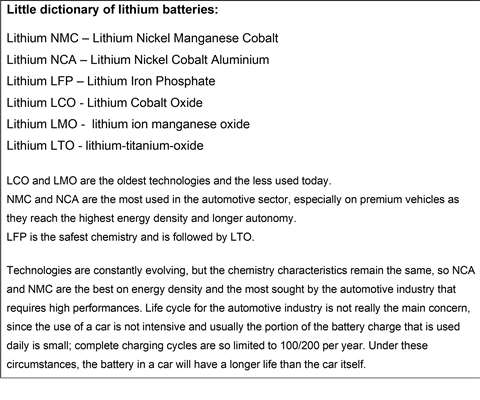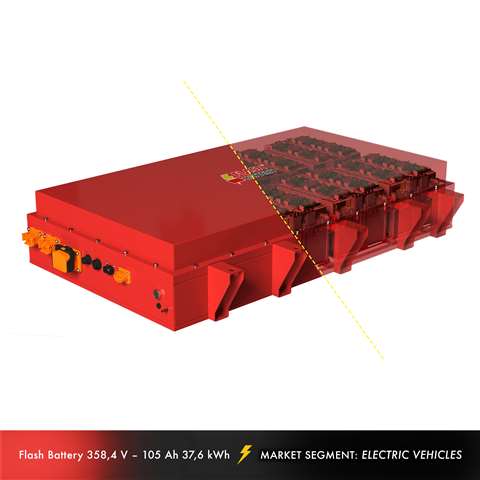The safe side of lithium batteries
01 April 2022
A conversation with Marco Righi, founder and CEO of Flash Battery
New Power Progress recently spoke to Marco Righi, CEO and founder of Flash Battery, about his company’s product development and safety in lithium batteries
New Power Progress: Referring to developments in batteries for industrial use, it seems that Lithium Iron Phosphate (LFP) batteries are the preferred choice for characteristics such as longer life cycle and safety. Will you explain these advantages in more detail?
Marco Righi: Among the available battery types, those utilizing LFP chemistry are the ones better responding to the needs of the industrial sector. LFP is the most stable and safe technology and is available in large capacity formats, something that is required by industrial and off-highway machinery as it avoids the parallel connection of several small units to reach the necessary capacity, which is a less stable solution that can compromise the safety of the entire working machine.

The intrinsic safety of the chemistry and the achievable life cycle are the most important parameters to consider when choosing what type of batteries is most suitable for a certain application. Flash Battery chose LiFePo4 chemistry for industrial and off-highway applications, as its operating life exceeds 4 000 charging cycles.
NPP: What are the limits of LFP technology?
Righi: The energy density: LFP chemistry has about 30% higher volume and weight than Lithium Nickel Manganese Cobalt (NMC) technology. For industrial and off-highway use these are not major problems though, as very often there is quite some space available on the machines; sometimes it is also necessary to add ballast in counterbalanced applications.
On the other hand, for those applications needing high power and light weight – as for example motorbikes or racing cars – more compact and lighter battery types need to be chosen even if the life cycle might be shorter.
For all those applications where energy is more important than power and where discharge cycles are longer, as in most industrial applications, safer and longer-life batteries like LFP are preferred.
NPP: It seems like LFP batteries need a much precise balancing and consequently a sophisticated control strategy. Flash Battery has developed its own control technology - would you explain its characteristics and peculiarities?
Righi: The software for Battery Management System (BMS) does make the real difference in optimally exploiting the battery technology, thus guaranteeing reliability and performance over time. It also has a crucial role in the charge and discharge phases, but even more in the recharging process.

Flash Balancing System is the proprietary electronic balancing system of Flash Battery; it acts on every single cell with a combined balancing – that is, both active and passive – which is 20 times superior to that of conventional lithium batteries in all phases.
This technology allows to have a balancing below 30 minutes in cyclical applications which makes it insignificant in the total time for recharging. The lithium cells are kept balanced and efficient for the whole battery life which is approximately 4 500 recharging cycles.
When a BMS is designed with care and attention to detail, it guarantees a complete control of the battery pack, including performance stability over time, malfunctioning prevention, self-diagnostic and predictive maintenance.
This is one of the reasons why Flash Battery developed its Flash Data Center, a proprietary platform that continuously analyses the charge and discharge cycles of the connected batteries. Through AI algorithms, the Center can prevent anomalies before they happen and sends automatic alerts to Flash Battery’s service center, so avoiding expensive stops in machines’ operation.
NPP: What is the future of batteries for industrial applications? Are there any alternatives in sight to LFP chemistry?
Righi: LFP chemistry is living a renewed success season. From the 100Wh/kg available a few years ago, now the performance has reached 170Wh/kg, so the automotive market has shown some interest too, as for example Tesla on its Model 3, or other companies like BYD and the Volkswagen Group on low performance cars.
We believe that LFP will still have quite a few success years ahead both in automotive as in industrial/off-highway applications.
NPP: Regarding safety of the LFP batteries, Flash Battery has listed a series of favorable characteristics - high decomposition temperature, lower heat dissipation, reaction to internal short-circuits, assembly capabilities. Can you explain these in detail?
Righi: Flash Battery has been able to guarantee the highest safety of its batteries by working on three main aspects: the choice of the right lithium chemistry, the correct assembly of the battery pack, and the proprietary electronic control system.
The fact that Flash Battery is focused on the industrial market only, allowed the company to work together with several European OEMs to deliver tailor-made batteries that meet the spaces available on the vehicles and that offer specific capacity and tension for the job at hand.
We did a comparison among the three main used battery types in industrial applications: NMC, NCA, and LFP, considering two characteristics: decomposition temperature, the highest this is the lowest chances to reach decomposition conditions so the lithium battery cell with be safer; and heat dissipation, it is measured in Joule per gram and indicates the energy that the battery cell is releasing as heat, the lower this value the safer the battery.
Our target is to identify the right battery technology for the vehicle of our customer. Our technicians in the R&D department do not just study the different chemistry types, but also perform stress test to analyse behaviour and try improvements. One of the tests we perform is the Nail Penetration Test, which consists of inserting a nail in the battery, simulating an internal short-circuit.
These are obviously tests conducted in laboratory under controlled conditions and the chance that a battery cell gets perforated during use is quite low. But we conduct this test to simulate the worst that can happen to a cell, that is an internal short-circuit due to eventual manufacturing fault or abuse.
Cell assembly is the second element contributing to safety. When lithium batteries are assembled in small size cells, it is necessary to add a lot of cells in parallel. Let’s take for example a battery pack of 400Ah: if it is composed of cylinder cells of 3Ah each you will need 130 cells in parallel. If it is composed of prismatic cells of 50Ah, you need only eight cells in parallel. In case one of these cells should short-circuit, in the first case it would be absorbing 130 times its capacity, in the second case only eight times.
Flash Battery packs are assembled with a maximum of four cells in parallel. According to our studies, it is the best configuration for our batteries to operate safely under any condition.
The third and last aspect to guarantee safety of lithium batteries is the electronics that controls the battery: the BMS. It is key to monitor the tension and temperature of each cell, as well as interact with the vehicles and the battery charger to stop charge and discharge in case of critical conditions and, if the case, intervene on contactors.
One of the differences between lithium battery manufacturers is the functioning of the control electronics in danger situations.
Flash Battery has built upon critical issues due to the electronics, that were limiting the reliability and safety of the batteries. This is where we decided to invest to differentiate from other manufacturers: the balancing system and the remote control. With Flash Battery products, temperature measurement is capillary and covers all key points, thus being able to verify even contact resistance thanks to two temperature sensors on each cell.
This interview appeared in New Power Progress, in the March/April issue of Diesel Progress International. Click HERE to read the whole issue.
STAY CONNECTED




Receive the information you need when you need it through our world-leading magazines, newsletters and daily briefings.
POWER SOURCING GUIDE
The trusted reference and buyer’s guide for 83 years
The original “desktop search engine,” guiding nearly 10,000 users in more than 90 countries it is the primary reference for specifications and details on all the components that go into engine systems.
Visit Now
CONNECT WITH THE TEAM









